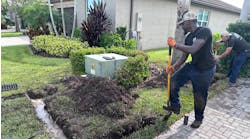BETHESDAS, MD. — Approximately 200 thought-leaders from the plumbing and water conservation sectors gathered here in the beginning of May to hear about and debate the latest technologies in the field. The gathering was the third biennial International Association of Plumbing & Mechanical Officials Emerging Technology Symposium. The symposium had been held in Ontario, Calif., in 2010 and in Chicago in 2008.
“Our goal is to minimize the impact of future water scarcity events and to minimize their effects on commerce,” said the event’s host, GP “Russ” Chaney, CEO of the International Association of Plumbing & Mechanical Officials and chairman of the event co-sponsor, the World Plumbing Council.
Attendees included representatives from government, academia, plumbing manufacturers, non-governmental organizations, health experts, and the associations representing contractors, engineers and water utilities.
As commercial buildings get more complicated, how to do you choose one technology over another, queried Tom Meyer, director of technical programs for the National Environmental Balancing Bureau. What if you save one natural resource and end up using more of another? Meyer and Bill Hoffman, H.W. (Bill) Hoffman & Associates LLC, Austin, Texas, addressed the water-energy nexus in buildings.
Thirty-six states will experience water shortages next year, Hoffman said, and water rates across the country are up 9.4%. In Chicago, water rates are expected to double over the next five years; in many locales water and sewer rates collide with energy conservation, such as with water-cooled ice machines or air conditioning.
A 750-ton cooling tower using 2.5 gal./ton-hour can use 33,000 gal. per day on a hot day when everyone is using lots of water, Hoffman pointed out. A cooling tower might save 3 cents to 5 cents per ton-hour over an air-cooled system, but the water and sewer costs may be 6 cents. Practitioners, therefore, must figure out the tipping points between water and energy, Meyer said.
The water and energy communities have not talked to each other, said Mary Ann Dickinson, president/CEO of the Alliance for Water Efficiency. Saving water saves energy, she pointed out, because water contains a lot of embedded energy to pump it, treat it and distribute it. AWE is working with the American Council for an Energy Efficient Economy to try to get the two sides working together.
Water can start fights. Shared water basins, such as the Rio Grande or the Mekong River means water plays a role in national security, said keynoter Kerri-Ann Jones, an assistant secretary at the U.S. State Department. The State Department is trying to impress on foreign finance ministers that their economies will pay a Gross Domestic Product penalty if they ignore water issues.
The best way to test potential WaterSense pre-rinse spray valves was to put them in restaurant kitchens and see how they performed, explained Stephanie Tanner, lead engineer for the U.S. Environmental Protection Agency’s WaterSense Program. The agency was gauging performance and looking for 20% water savings. Pre-rinse spray valves use lots of hot water, and plumbing manufacturers and the EPA have looked at valves in the laboratory that use less than 1.0-GPM. There’s an ASTM lab test that measures how many seconds it takes to rinse tomato paste off a plate.
Researchers, however, wanted to see how well they worked in real life, so they picked out 10 restaurants, plus the dining halls at Boston College and Harvard. They tested valves flowing between 1.6-GPM to 1.0-GPM, hooking them up to data loggers to measure temperatures and pressures. The conclusion was that yes, indeed, they save water, but the dishwashers were unhappy, especially with the valves flowing 1.0-GPM or less. They had the perception that it took longer to clean plates even if it didn’t. EPA, with the aid of Bill Gauley, principal engineer, and a partner in Veritec Consulting in Mississauga, Ont., has developed a force test and a spray force gauge for lab tests.
EPA may release a draft specification this fall, Tanner said, and, since spray valves use heated water, the listed valves will most likely carry both an Energy Star and WaterSense label.
Watts Water Technologies will introduce a machine that uses electromagnetic flux to fuse joints in plastic pipe, said Stephen Barrett, a product director for Watts. The march toward plastic pipe, which surpassed metallic pipe in 2005, is inexorable. Watts developed the new joining method, which will work on all types of plastic pipe, to be leak proof, low-skill and full flow.
Watts will manufacture all of the fittings, which will contain an iron ring inside. The “fuser” of the electro-fusion welding machine, which runs on 120V AC, goes around the fitting. The electromagnetic flux heats up the iron ring, melting and fusing the plastic around the joint. The device creates no external heat or electromagnetic flux outside of the fuser and it draws about 100W.
Dried up trap seals can allow pathogens to spread through a building, as they did in 2002-2003 when more than 900 persons in Asia died of Severe Acute Respiratory Syndrome, related Steven White, director and product manager for Dyteqta International Ltd. Tall buildings and multi-building campuses with many traps are at a greater risk of having undetected dry traps. White’s firm has developed a device that works on sonar that can detect dry traps based on the time and distance it takes for a 10 Hz low amplitude pressure wave to return to the device. It takes three seconds to test each stack. The device can tie in with a building management system. On old buildings where the as-built drawings are missing, the machine can create a map of the DWV system.

